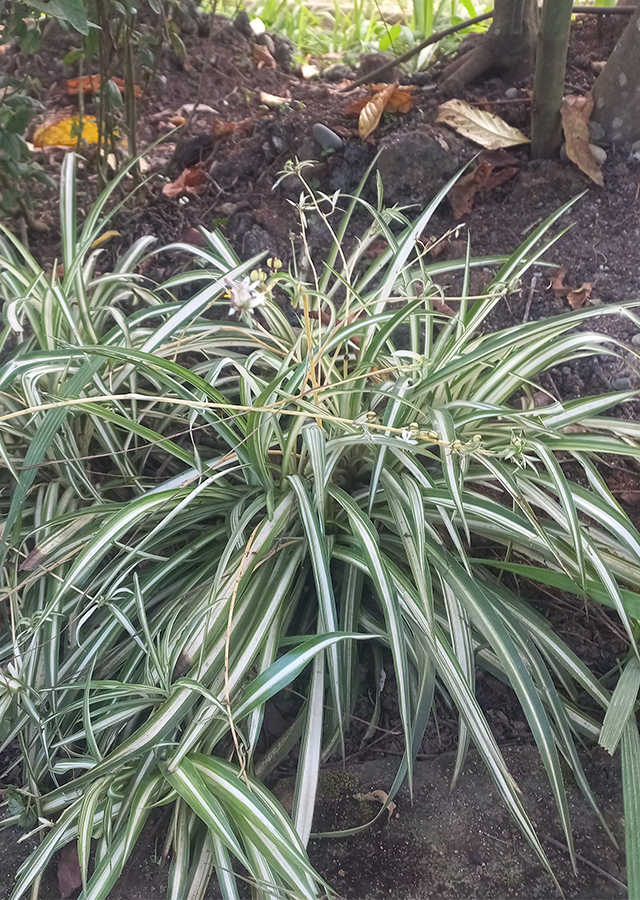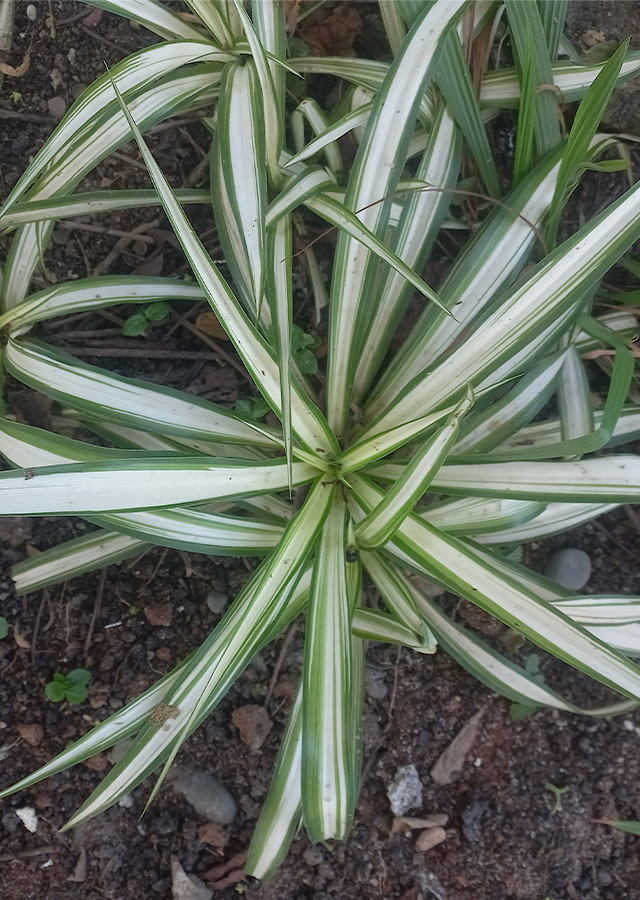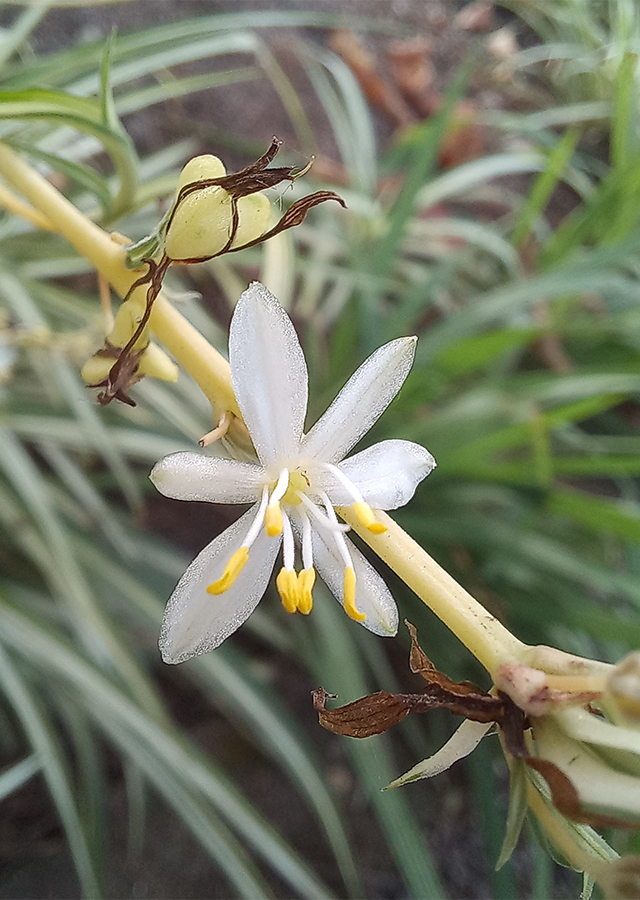Spider Lily
Chlorophytum comosum (Thunb.) Jacques
Asparagaceae
Location in our garden
Principal



Synonym
Anthericum comosum Thunb.
Hartwegia comosa (Thunb.) Nees
Hollia comosa (Thunb.) Heynh.
Habitus
Herbaceous. Grass-like evergreen, clump-forming perennial herbaceous plant growing 0.4-0.5 m tall
Part Used
Leaves
Roots
The Whole Plant
Growing Requirements
Need Shade
Habitat
Forest
Mountains
Terrestrial
Overview
Chlorophytum comosum is native to Central and South Africa. More precisely, the tropical and subtropical zone of the continent, which includes from west Liberia, Côte d’Ivoire, Nigeria and Cameroon and to the east almost all countries from Ethiopia to South Africa. It is highly adaptable to environments suitable for its development. It has been fully naturalised in Ecuador, Tunisia, Bangladesh, Myanmar, the Korean Peninsula, and Western and Eastern Australia. Especially in Australia it has even been classified as invasive weed. It is used as a medicine, has environmental uses and social uses and for food. It is used in traditional systems of medicine including Ayurveda, Unani, and homeopathy. In Chinese tradition, the extract of the spider plant is used against bronchitis and cough-related problems. Spider plant is considered among the easiest air-purifying plants to grow. It is effective in removing harmful chemical from the air, such as carbon monoxide, xylene, formaldehyde and toluene.
Vernacular Names
Plante araignée (French), Spinnenpflanze (German), Spindelväxt (Swedish), Pianta ragno (Italian), Planta araña (Spanish), Kumo shokubutsu (Japanese), Tumbuhan labah-labah (Malay), P ng kuu a pain (Burmese), Phụ̄ch mængmum (Thai), Mạng nhện (Vietnamese), Zhīzhū zhíwù (Chinese).
Agroecology
Occurs in a variety of environments ranging from sea level up to 1,000 m and on sedimentary or volcanic soils, which are derived from granite, dolerite, shale and sandstone, in the undergrowth of forested river valleys, mountainous regions and thickets, on steep embankments, flat terrain and cliffs. In its natural niches the average annual rainfall is between 500 and 2,000 mm. It can not withstand the frost. The minimum temperatures, which are also the lowest strength limit, range between -1.1 and -3.9 °C. At temperatures between 0 and -3.9 °C, its overground part is completely destroyed, but in the spring the plant regrows.The most suitable temperatures for its development are those between 18 and 32 °C. It grows with pH in over a wide range of values, ranging from 5.5 to 7.5, but thrives on slightly acidic soils with values ranging from 6 to 6.5. Spider plants can be planted or placed in half-shaded sites. However, when grown as indoor plants it is recommended to always place them in extremely bright places, especially the highly decorative variegated leaves varieties.
Morphology
- Root - has a dense root system consisting of thickened elongated white fleshy tubers and fine roots. The tubers have a conical shape at both ends, their length being between 5 and 10 cm and diameter between 0.5 and 1 cm.
- Stem - short and stout with very short internodes, while flower stalks are stiff, wiry, and lightly scabrous.
- Shoots - they are the characteristic shoots that grow sideways. From each nobe of the stolon, the spiderettes form leaves and roots.
- Leaves - rise directly from the rhizome to form a rosette, simple, without petiole, linear-lanceolate, of alternate arrangement and have a deep green color. The lamina is flat, with parallel ribs, entire or slightly undulate margined, leading to a pointed tip. The dimensions of the leaves vary in length between 20 and 45 cm and in the width between 0.6 and 2.5 cm.
- Flowers - monoecious (hermaphrodite) and complete their biological cycle within a few hours. They are brought 1 to 6 together on a paniculate inflorescence, the axis of which is initially erect, but in full growth curves, forming an arc of 30 to 75 cm in length. Each individual flower has a star-like shape, white, diameter of 1.8 to 2 cm and consists of 3 elongated sepals and 3 petals 0.6 to 1 cm long. Stamens are 6, with fine filament of 0.3 to 0.5 cm in length, with an anther of 0.3 to 0.35 cm long. The style is short and smooth with a tiny and capitate stigma.
- Fruit - tiny triangular deeply lobed three-celled leathery capsule, 3–8 mm long containing 9 to 45 seeds.
- Seeds - flattish, black, smooth and shiny.
Cultivation
Vegetatively propagated by division of rhizomes and from plantlets.
Chemical Constituents
Fatty acids, isoprenoid and steroid compounds.
Traditional Medicinal Uses
- Root extracts help in reducing the inflammatory process of the liver thus help in healing, helps in suppressing the tumor activity by apoptosis or death of the cell (anticancer).
- Leaves helps in establishing the intestinal microorganisms thus acts as a potential prebiotic substance for a healthy bowel movement and healthy stomach.
- Whole plant extract helps in reducing the cough and thus relaxing the chest congestion.
- Chinese tradition uses plants extract for healing fractured bone and burns.
- Infusion is given to young babies as purgative.
Part Used
Reference Sources
- Health Benefit Times. (No date). Health benefits of Spider Plant: Spider Plant Chlorophytum comosum. https://www.healthbenefitstimes.com/spider-plant/. 13-09-2022.
- Kew Royal Botanic Gardens. (No date). Plants of the World Online: Chlorophytum comosum (Thunb.) Jacques. https://powo.science.kew.org/taxon/urn:lsid:ipni.org:names:532810-1#synonyms. 13-09-2022.
- Kalliergeia. (No date). Spider Plant (Chlorophytum comosum) - Description and Uses. https://www.kalliergeia.com/en/spider-plant-chlorophytum-comosum-description-uses/. 13-09-2022.
- Rzhepakovsky, Igor V, et al. (2022). Phytochemical Characterization, Antioxidant Activity, and Cytotoxicity of Methanolic Leaf Extract of Chlorophytum Comosum (Green Type) (Thunb.) Jacq. Molecules 2022, 27, 762. https://doi.org/10.3390/molecules27030762.


